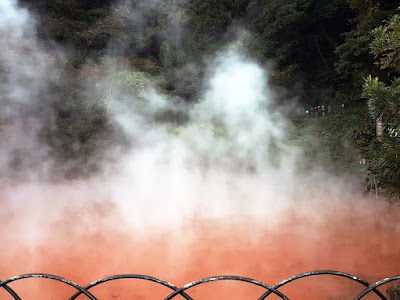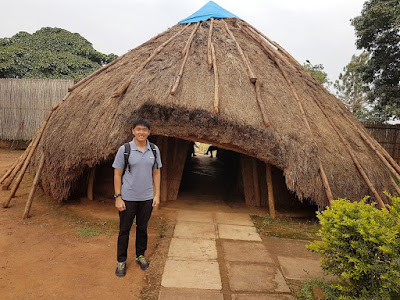JPN: Seven Hells of Beppu (Part 2)
Beppu, Oita, Japan
Upon entering Oniyama Jigoku (lit. Demon Mountain Hell), we were greeted with a copious amount of steam from the geothermal pool with an average temperature of 98 degree Celsius.


You don't need to go to the Amazon to see piranhas as there are some in the premise.

Daily: 8.00am - 5.00pm
In the previous post, I've written on three of Seven Hells of Beppu: Oniishi Bozu, Umi and Kamado. Today, we shall take a look at the other four: Oniyama and Shiraike in Kannawa district, as well as Tatsumaki and Chi No Ike in Shibaseki district. There's actually one more 'hell' besides those seven that my BFFs and I didn't go to.
---
JPN: Hotel Sunline Fukuoka Hakata Ekimae
JPN: Nagahama Fish Market Centre
JPN: Korokan Ruins Museum
JPN: Maizuru Park
JPN: Ohori Park
JPN: Kushida Shrine
JPN: Tocho-ji & Shofuku-ji
JPN: Fukuoka Downtown
JPN: Fukuoka Uptown
JPN: Yufuin No Mori 3
JPN: Tenku Yubo Seikaiso
JPN: Seven Hells of Beppu (Part 1)
JPN: Seven Hells of Beppu (Part 2) <YOU ARE HERE!>
JPN: Beppu Downtown
JPN: Yufuin Kotobuki Hananosho
JPN: Yunotsubo Street
JPN: Kinrin Lake
JPN: Yufuin Downtown
JPN: Hotel Route-Inn Kumamoto Ekimae
JPN: Kumamoto Castle
JPN: Kumamon Square
JPN: Kumamoto Downtown
JPN: Tsubame 322 & Huis Ten Bosch 11
JPN: Hotel Okura JR Huis Ten Bosch
JPN: Town of Sasebo
JPN: Mameshiba Café
JPN: Huis Ten Bosch (Part 1)
JPN: Huis Ten Bosch (Part 2)
JPN: Nagahama Fish Market Centre
JPN: Korokan Ruins Museum
JPN: Maizuru Park
JPN: Ohori Park
JPN: Kushida Shrine
JPN: Tocho-ji & Shofuku-ji
JPN: Fukuoka Downtown
JPN: Fukuoka Uptown
JPN: Yufuin No Mori 3
JPN: Tenku Yubo Seikaiso
JPN: Seven Hells of Beppu (Part 1)
JPN: Seven Hells of Beppu (Part 2) <YOU ARE HERE!>
JPN: Beppu Downtown
JPN: Yufuin Kotobuki Hananosho
JPN: Yunotsubo Street
JPN: Kinrin Lake
JPN: Yufuin Downtown
JPN: Hotel Route-Inn Kumamoto Ekimae
JPN: Kumamoto Castle
JPN: Kumamon Square
JPN: Kumamoto Downtown
JPN: Tsubame 322 & Huis Ten Bosch 11
JPN: Hotel Okura JR Huis Ten Bosch
JPN: Town of Sasebo
JPN: Mameshiba Café
JPN: Huis Ten Bosch (Part 1)
JPN: Huis Ten Bosch (Part 2)
---
[Oniyama Jigoku]
Kannawa District, Beppu, Oita, Japan
Upon entering Oniyama Jigoku (lit. Demon Mountain Hell), we were greeted with a copious amount of steam from the geothermal pool with an average temperature of 98 degree Celsius.
 |
| Was I standing at the entrance to the underworld? |

 |
| When harnessed, the pressure from the steam can pull one and a half train cars. |
Why not take a look at the short video clip on the rising steam?
The premise is an ideal breeding ground for crocodiles. The reptiles were first reared there in 1923.
 |
| Must be nice to cuddle together in winter~ |
Interestingly, there's a recreation of a traditional house of Sarawak, Malaysia. Inside is a small exhibition space, which mentions that some of the crocodiles were indeed brought from the state in Borneo.
 |
| That feeling of being in a kampung (lit. village)~ |
 |
| Such a huge preserved Borneo crocodile! |

 |
| Waiting to be fed? |
[Shiraike Jigoku]
Kannawa District, Beppu, Oita, Japan
True to its name, Shiraike Jigoku (lit. White Pond Hell) features a milky bluish-white geothermal pool.
 |
| The average temperature is 95 degree Celsius. |
 |
| Some of the naturally-occurring chemicals responsible for its colour include boric acid, sodium chloride and calcium bicarbonate. |
 |
| It's said that Ippen Shonin, who founded the Ji-shu branch of Pure Land Buddhism, arrived at Beppu in 1276 and laid the foundation for the development of what was then a hot spring village. |
 |
| Did you know that not all piranhas eat meat? Some are actually vegetarian. |
 |
| Even if one doesn't understand Japanese, I'm sure that diagram is easy enough to understand. |
There's another aquarium where you can see other tropical fishes.

 |
| Arapaima is one of the largest freshwater fishes in the world, which can attain a length of nearly 3 m and a weight of 220 kg. |
 |
| Hello, catfish! Don't be shy! |
[Tatsumaki Jigoku]
Shibaseki District, Beppu, Oita, Japan
To go the last two 'hells', we walked through the descending path from Shiraike Jigoku to Kannawa Bus Terminal. From there, we took Bus #16.
 |
| Alternatively, Bus #16A and Bus #29 can also bring you to the Shibaseki district. |
Tatsumaki Jigoku (lit. Tornado Hell) is a geyser that erupts every 30 to 40 minutes, lasting for up to 10 minutes in each cycle. Having an average temperature of 105 degree Celsius, the water jet has the potential to shoot up to 30 m, but it's hindered by the stone plate above it for safety reasons.
 |
| You may want to sit there while waiting for the geyser to erupt. |
Here's a short video clip of the geyser in action.
The moment I saw amazake (Japanese sweet, non-alcoholic fermented rice wine) being sold at the shop, I just had to grab it since I love it so much. Priced at ¥200 (~S$2.50), it warmed my body and soul.
[Chi No Ike Jigoku]
Shibaseki District, Beppu, Oita, Japan
Chi No Ike Jigoku (lit. Blood Pond Hell) is the oldest natural hot spring in Japan, having existed for more than 1,300 years. Even though it doesn't appear as red as blood, its vivid colour is due to red mud containing chemicals such as iron oxide and magnesium oxide.
 |
| The average temperature is 78 degree Celsius. |
You can climb a flight of stairs to see the hot spring from a greater height.
Hot foot bath to soothe your muscles and hydrates your skin, anyone?
We had about 8 minutes to browse the gift shop before the premise was closed for the day. Apparently, it sells jars of ointment containing the red mud from the hot spring that's known to have healing properties.
Feeling satisfied for the day, we walked to the bus stop across the road from Chi No Ike Jigoku and took one of the buses that brought us back to Beppu railway station.
Last but not least, here are the stamps that I collected from the seven 'hells'.
I remember I mentioned earlier about the 'hell' that we didn't visit. It's called Yama Jigoku (lit. Mountain Hell). In addition to a geothermal pool, you can also see and feed animals that live there, such as flamingoes, peacocks, monkeys and hippopotamuses.





























Comments
Post a Comment